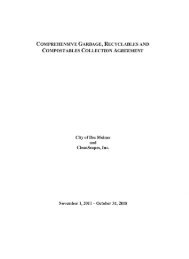CITY OF DES MOINES SHORELINE MASTER PROGRAM
CITY OF DES MOINES SHORELINE MASTER PROGRAM
CITY OF DES MOINES SHORELINE MASTER PROGRAM
Create successful ePaper yourself
Turn your PDF publications into a flip-book with our unique Google optimized e-Paper software.
Des Moines Shoreline Inventory and Characterization<br />
NEARSHORE BIOLOGICAL CHARACTERIZATION<br />
Wetlands<br />
Wetlands near the Puget Sound shoreline typically include tidal marshes and tidally influenced<br />
estuaries. Tidal marshes include salt and freshwater habitats that experience tidal inundation<br />
(KCDNR, 2001). Several wetlands have been mapped by various sources in the City’s shoreline<br />
jurisdiction. According to the 1987 National Wetlands Inventory (NWI), the entire area of the<br />
City’s shoreline jurisdiction in the city limits is designated as “estuarine intertidal regularly<br />
flooded unconsolidated shore” wetland or “estuarine intertidal regularly flooded aquatic bed”<br />
wetland (USDI, 1987a and 1987b) with the exception of Segment B, which contains the built out<br />
marina. The King County Sensitive Areas Map Folio (King County, 1990) also identifies Class<br />
1 intertidal wetlands encompassing all of Segments C through G within the City’s shoreline<br />
jurisdiction (Figure 13). Neither indicates the presence of tidal wetlands associated with the<br />
streams that occur within the City’s shoreline jurisdiction. This is likely due to the presence of<br />
riprap along the stream channels extending from the mouth upstream for a majority of the<br />
streams, thus cutting off potential connections with interior wetlands. Seasonal palustrine<br />
emergent wetlands are associated with Des Moines Creek within the lower portion of Des<br />
Moines Creek (Segment A). Hydric soils are mapped along portions of Segments A, most of<br />
Segments C and D, and portions of Segment E (NRCS, 1973).<br />
Much of the nearshore area within the City’s shoreline jurisdiction is heavily developed<br />
(Segments B, C, E, F, and G), and the presence of the Marina (Segment B), moderate to steep<br />
cliffs (Segments C, D, and E), residential and commercial development, and shoreline armoring<br />
along most of segments A, C, D, E, F, and G have eliminated historical wetlands or prevent<br />
connections between interior wetlands and the nearshore area.<br />
Critical Fish and Wildlife Areas<br />
Critical fish and wildlife habitat areas are those areas identified as being of critical importance in<br />
the maintenance and preservation of fish, wildlife and natural vegetation. Critical fish and<br />
wildlife habitat areas are defined in Chapter 18.04.287 (DMMC) as follows:<br />
Fish and wildlife habitat conservation areas include: areas with which<br />
endangered, threatened, and sensitive species have a primary association;<br />
habitats and species of local importance; all public, and private tidelands or<br />
bedlands suitable for commercial or recreational shellfish harvest; kelp and<br />
eelgrass beds identified by the washington Department of Natural resources;<br />
Herring and smelt spawning areas as outlined in Chapter 220-110 WAC and<br />
the Puget Sound Environmental Atlas as presently constituted or as may be<br />
subsequently amended; Naturally occuring ponds under 20 acres and their<br />
submerged aquatic beds that provide fish or wildlife habitats; Waters of the<br />
state as defined in Title 222 WAC; Lakes, ponds, streams, and rivers planted<br />
with game fish by a govermental or tribal entity; and State natural area<br />
preserves and natural resource conservation areas as defined, established, and<br />
managed by the Washington Department of Natural Resources.<br />
Page 30 March 2005



